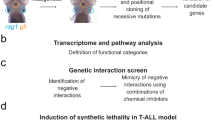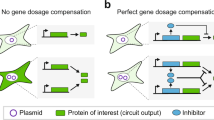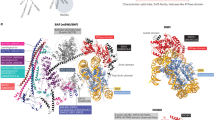Summary
Recessive lethals on the second chromosome were extracted from genetically isolated populations in Australia and the U.K. The frequency of allelism, used in a manner analogous to capture-recapture of animal populations, indicated that the number of genes capable of mutating to lethal had a 95 per cent probability of being in the range 247 to 1140, although excluding possible heterotic and synthetic lethals altered this to 309 to 3568. Possible sources of bias are discussed. The disagreement between these values and those obtained the direct measurements of DNA (more than 10 times greater) is clear. It is suggested that many of the genes of eukaryotes have been duplicated by unequal exchange during recombination and occur in functionally related groups or in supergenes. Some consequences of this hypothesis to population genetics are noted.
Similar content being viewed by others
Article PDF
References
Baker, R F, and Thomas, C A. 1977. The origin and complexity of inverted repeat DNA sequences in Drosophila. In DNA Insertion Elements, Plasmids and Episomes, eds. A. I. Bukhari, J. A. Shapiro and S. L. Adhya, pp. 463–469. Cold Spring Harbor Laboratory.
Bishop, J A, Hartley, D J, and Partidge, G G. 1977. The population dynamics of genetically determined resistance to warfarin in Rattus norvegicus from mid Wales. Heredity, 39, 389–398.
Bishop, J A, and Sheppard, P M. 1974. An evaluation of two capture-recapture models using the technique of computer simulation. In The Mathematical Theory of the Dynamics of Biological Populations, eds. M. S. Bartlett and R. W. Hiorns, pp. 235–252. Academic Press, London and New York.
Blower, J G, Cook, L M, and Bishop, J A. 1981. Estimating the Size of Animal Populations. George Alien and Unwin, London.
Bodmer, W F. 1979. Gene clusters and the HLA system. In Human Genetics: Possibilities and Realities, CIBA Foundation Symposium 66 (new series), pp. 205–223. Elsevier/North Holland, Amsterdam and New York.
Crow, J F, and Kimura, M. 1972. An Introduction to Population Genetics Theory. Harper and Row, New York.
Devonshire, A L, and Sawicki, R M. 1979. Insecticide-resistant Myzus persicae as an example of evolution by gene duplication. Nature (London) 280, 140–141.
Dobzhansky, Th, and Wright, S. 1941. Genetics of natural populations. V. Relations between mutation rate and accumulation of lethals in populations of Drosophila pseudoobscura. Genetics, 26, 23–51.
Fyrberg, E A, Kindle, K L, Davidson, N, and Sodja, A. 1980. The actin genes of Drosophila: a dispersed multigene family. Cell, 19, 365–378.
Garcia-Bellido, A, and Ripoll, P. 1978. The number of genes in Drosophila melanogaster. Nature, London, 273, 399–400.
Gelbart, W M, and Chovnick, A. 1979. Spontaneous unequal exchange in the rosy region of Drosophila melanogaster. Genetics, 92, 849–855.
Hartley, B S. 1970. Homologies in serine proteinases. Phil Trans Roy Soc Land B, 257, 77–87.
Hartley, B S. 1979. Evolution of enzyme structure. Proc Roy Soc Land B, 205, 443–452.
Harris, H. 1979. Multilocus enzymes in man. In Human genetics: possibilities and realities. CIBA foundation symposium 66 (new series) pp. 187–199. Elsevier/North Holland, Amsterdam and New York.
Hochman, B. 1976. The fourth chromosome of Drosophila melanogaster. In The Genetics and Biology of Drosophila, eds. M. Ashburner and E. Novitski, Vol. Ib, pp. 903–928. Academic Press, London and New York.
Ives, P T. 1945. The genetic structure of American populations of Drosophila melanogaster. Genetics, 30, 167–196.
Jones, J S, and Parkin, D T. 1977. Attempts to measure natural selection by altering gene frequencies in natural populations. In Measuring Selection in Natural Populations. Eds. F. B. Christiansen and T. M. Fenchel, Lecture Notes in Biomathematics 19, 83–96. Springer-Verlag, Berlin, Heidelburg and New York.
Judd, B H, Shen, M W, and Kaufman, T C. 1972. The anatomy and function of a segment of the X chromosome of Drosophila melanogaster. Genetics, 71, 139–156.
Judd, B H. 1976. Genetic units of Drosophila-complex loci. In The Genetics and Biology of Drosophila, eds. M. Ashburner and E. Novitski, Vol. Ib, pp. 767–799. Academic Press, London and New York.
Krone, W, and Wolf, U. 1978. Chromosomes and protein variation. In The Biochemical Genetics of Man, eds. D. J. H. Brock and O. Mayo, 2nd ed. pp. 93–154. Academic Press, London and New York.
Lauer, J, Shen, J C-K, and Maniath, T. 1980. The chromosomal arrangement of human α-like globin genes: sequence homology and α-globin deletions. Cell, 20, 119–130.
Laird, C D, and McCarthy, B J. 1969. Molecular characterisation of the Drosophila genome. Genetics, 63, 865–882.
Lewontin, R C. 1974. The Genetic Basis of Evolutionary Change. Columbia University Press, New York and London.
Lewontin, R C, and Prout, T. 1956. Estimation of the number of different classes in a population. Biometrics, 12, 211–223.
McKenzie, J A. 1974. The distribution of vineyard populations of Drosophila melanogaster and Drosophila simulans during vintage and non-vintage periods. Oecologia (Berl), 15, 1–16.
Mayo, O. 1970. The role of duplications in evolution. Heredity, 25, 543–553.
Ohno, S. 1970. Evolution by Gene Duplication. Springer, Berlin.
Pavan, C, and Knapp, E N. 1954. The genetic population structure of Brazilian Drosophila willistoni. Evolution, 8, 303–313.
Peacock, W J, Brutlag, D, Goldring, E, Appels, R, Hinton, C W, and Lindsley, D L. 1974. The organisation of highly repeated DNA sequences in Drosophila melanogaster chromosomes. Cold Spring Harbor Symposium in Quantitative Biology, 38, 405–416.
Ris, H, and Kubai, D F. 1970. Chromosome structure. Ann Rev Genet, 4, 263–294.
Schalet, A, and Lefevre, G. 1976. The proximal region of the X chromosome. In The Genetics and Biology of Drosophila, eds. M. Ashburner and E. Novitski, Vol. 1b, pp. 847–902. Academic Press, London and New York.
Spofford, J B. 1969. Heterosis and the evolution of duplications. Am Nat, 103, 407–432.
Van Der Ploeg, L H T, Konings, A, Oort, M, Roos, D, Bernini, L, and Flavell, R. 1980. γ-β-Thalassaemia studies showing that deletion of the γ-and δ-genes influences β-globin gene expression in man. Nature (London), 283, 637–642.
Walker, P M B. 1979. Genes and non-coding DNA sequences. In Human Genetics: Possibilities and Realities. CIBA foundation symposium 66 (new series), pp. 25–38. Elsevier/North Holland, Amsterdam and New York.
Wallace, B. 1950. Allelism of second chromosome lethals in Drosophila melanogaster. Proc Nat Acad Sci US, 36, 654–657.
Weatherall, D J, Clegg, J B, Wood, W H, and Pasvol, G. 1979. Human haemoglobin genetics. In Human Genetics: Possibilities and Realities. CIBA foundation symposium 66 (new series) pp. 147–174. Elsevier/North Holland, Amsterdam and New York.
Wright, S, Dobzhansky, Th, and Hovanitz, W. 1942. Genetics of natural populations. VII. The allelism of lethals in the third chromosome of Drosophila pseudoobscura. Genetics, 27, 363–394.
Acknowledgements
Acknowledgements.-We are grateful to D. A. Ritchie and P. Strike for discussion and to L. M. Cook, O. Mayo and N. K. Todd who commented on the manuscript. J. McKenzie generously provided the material from Chateau Tahbilk in Australia.
Author information
Authors and Affiliations
Rights and permissions
About this article
Cite this article
Bishop, J., Keill, C. & MacNair, M. The number of genes on the second chromosome of Drosophila melanogaster and a comment on the genetic structure of eukaryotes. Heredity 46, 151–159 (1981). https://doi.org/10.1038/hdy.1981.23
Received:
Issue date:
DOI: https://doi.org/10.1038/hdy.1981.23
This article is cited by
-
Genetics of salt tolerance in higher plants: theoretical and practical considerations
Plant and Soil (1985)



